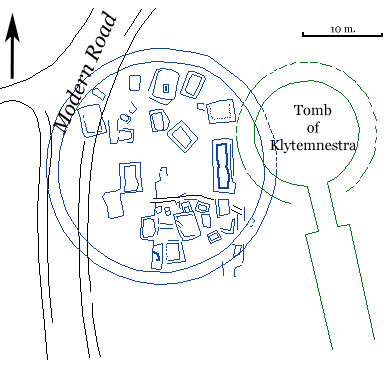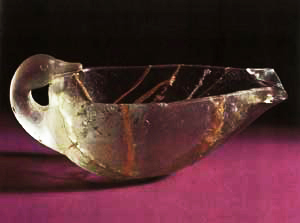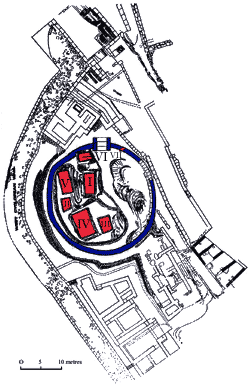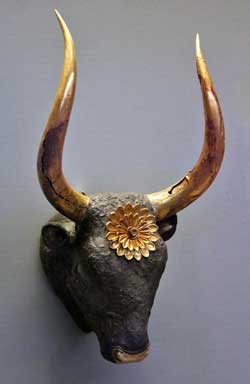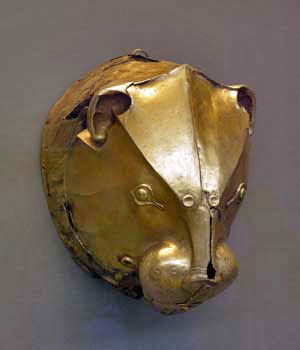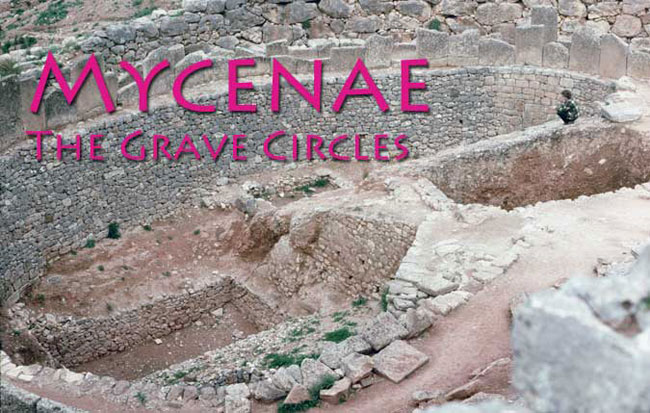
Grave Circle B
Also beyond the citadel walls were the graves of the earliest kings of Mycenae and their families, dating to the beginning of the Late Helladic I period (ca. 1650- 1550 BC). They were enclosed by a low circular wall about 28 metres in diameter. The circle partly underlay a later tholos tomb, known as the Tomb of 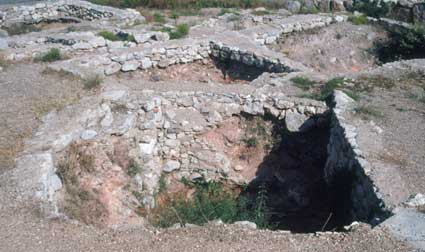 Klytemnestra, and was discovered in the course of restoration work to it in 1951. Only a small segment and a few stones of the encircling wall have survived In part this is due to the construction of the Tomb of Klytemnestra but most of the destruction resulted from the building of the modern road to the site. It was a double wall of roughly cut stone slabs with a fill of earth and smaller stones.
Klytemnestra, and was discovered in the course of restoration work to it in 1951. Only a small segment and a few stones of the encircling wall have survived In part this is due to the construction of the Tomb of Klytemnestra but most of the destruction resulted from the building of the modern road to the site. It was a double wall of roughly cut stone slabs with a fill of earth and smaller stones.
The small cemetery contained 10 small cist graves typical of the immediately preceding Middle Helladic period— simple boxes built of stone slabs with little evidence of wealth or status. The rest of the graves, 14 in all, are what are known as shaft graves. These were larger and deeper, often containing more than one burial. They were much richer too.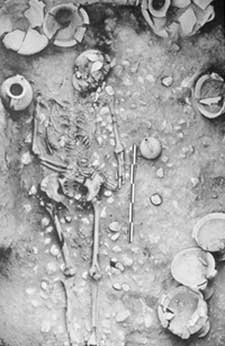
The Shaft Graves are rectangular and anywhere up to 4 metres deep. The largest, Grave Gamma, measures 3.8 x 2.8 metres and the smallest, Grave XI, is about two-thirds that size. The lower sections of the side walls were shored up with masonry or brickwork forming a ledge a metre or so up. This was used to support a roof which was made of either timber beams or flagstones. The rest of the shaft was filled with dirt forming a small mound at the top. There is evidence of some sort of funeral feast— cooked bones and broken drinking vessels were heaped up on top of the fill before the mounding was complete. Finally, some sort of marker— usually a carved stele — was erected on top. All of this, of course, had to be removed to permit the interment of additional bodies.
The bodies were laid out, normally extended and on their backs, on a bed of pebbles at the bottom of the shaft (as seen, right, in Grave Upsilon). They were decked out in all of their finery, their robes decorated with gold ornaments and wearing their best jewellery. Grave goods consisting of offerings of food and drink in clay and metal containers along with personal items such as weapons were placed next to the deceased. The most significant finds were an electrum mask found in Grave Omicron and a vase made out of rock crystal, carved in the shape of a duck. The number and quality of the grave goods is far less than those from the slightly later Grave Circle A. However it does represent a marked increase in wealth compared with graves from earlier periods.
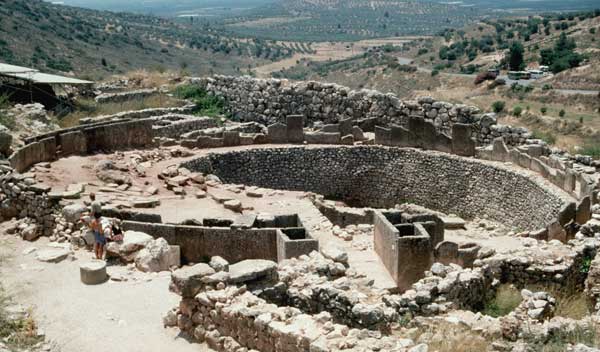
Mycenae.Circle A from the top of the Lion Gate
Grave Circle A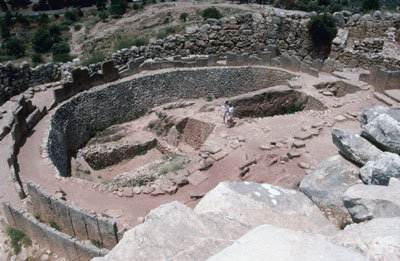
Circle A is very similar in layout to Circle B but slightly later, dating to the period from about 1580-1500 BC. It is located just inside the Lion Gate but only after the extension of the ramparts in the 13th century BC— before that it was outside the walls. It was about the same size as Circle B, about 27 metres in diameter, and was surrounded by a similar parapet wall. The wall here is much better preserved and consists of a double row of vertical slabs about 1 metre high. The space in between the row was filled with earth and the whole thing capped with more stone slabs. The entrance lies to the north, facing the Lion Gate, and it similar in construction to the rest of the wall.
Within the circle were 6 shaft graves and a number of earlier cists. The shafts are more or less oblong and range in size from 3 x 3.5 metres (II) and 4.5 x 6.5 metres (VI) and are up to 4 metres deep. They were built in a similar fashion to those in Circle B. The remains of 19 inhumations (8 men, 9 women and 2 children) were found accompanied by rich grave goods—far more than was the case in Circle B.
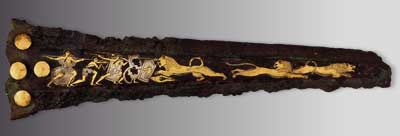
Bronze Dagger from Grave Circle A
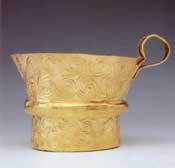
A large number of bronze swords and daggers, many with engraved decoration or inlays on their blades, accompanied the males. The best examples, inlaid with hunting or ‘nature’ scenes come from Graves IV and V. Apparently they had been wrapped in linen. Spearheads, arrowheads and knives were also found beside men but there were no shields or body armour. However, flakes of boar’s tusks, which may have come from a helmet, were found in Grave IV .
Gold and silver cups had been placed next to both men and women. In Grave IV, three rhytons were found— the silver Siege Rhyton (which shows an attack on a city), a gold rhyton in the shape of a lion’s head and another of silver and gold in the shape of a bull’s head.
 |
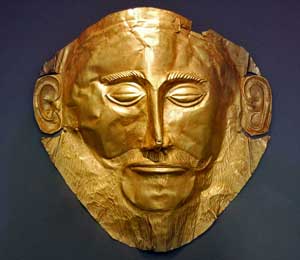 |
Gold Masks from Circle A with the Mask of Agamemnon on the right
Gold masks had been placed on the faces of five men in Graves IV and V. By far the most accomplished of these is the so-called ‘Mask of Agamemnon’. It is so different from the others that some scholars have questioned its authenticity.
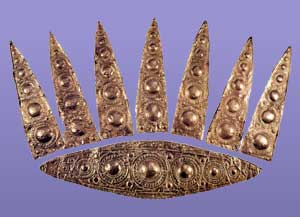 |
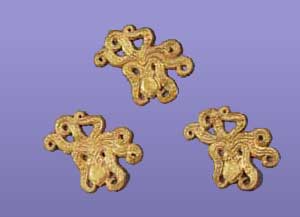 |
Gold Ornaments from Circle A including a diadem from Grave III (left), Octopuses from Grave IV (right) and a Griffen from Grave III (below)
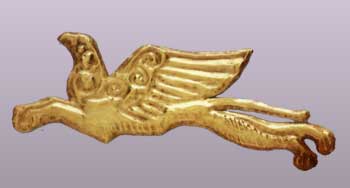
Women wore gold diadems or gold bands on their heads and their clothing was decorated with gold discs. Over 700 such discs, decorated with spirals, floral patterns and animals, were found in Grave II alone. Gold rings with carved bezels and gold figures (including one of a tripartite shrine), gold buttons and boxes covered with gold-leaf were also found.
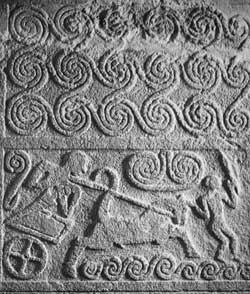
Stele from Circle A. Mycenae
Stelae, both plain and carved with reliefs, were found in the fill of the circle— it has been suggested that the plain ones had marked women’s graves, but there is no real evidence to support the idea. Three of the decorated ones bore reliefs of men in chariots, possibly hunting but more likely racing in funeral games.

